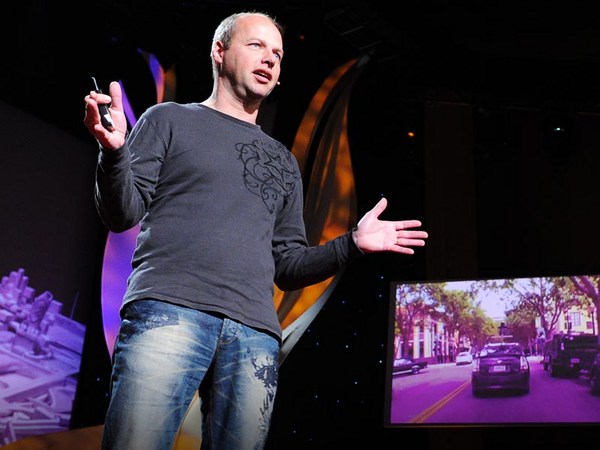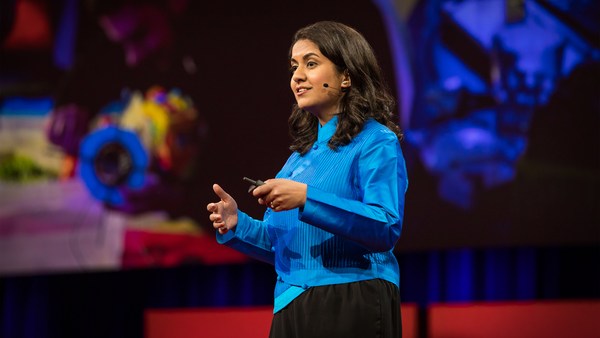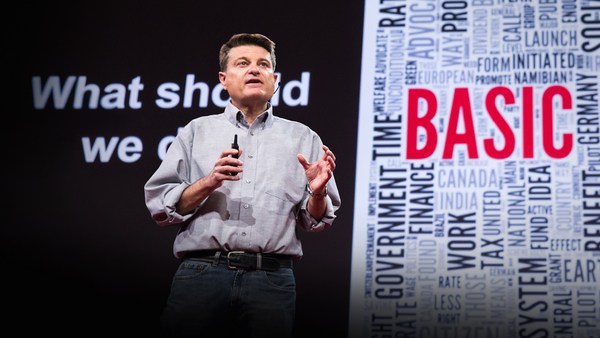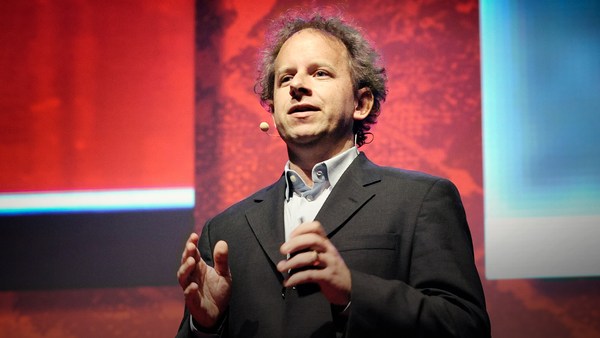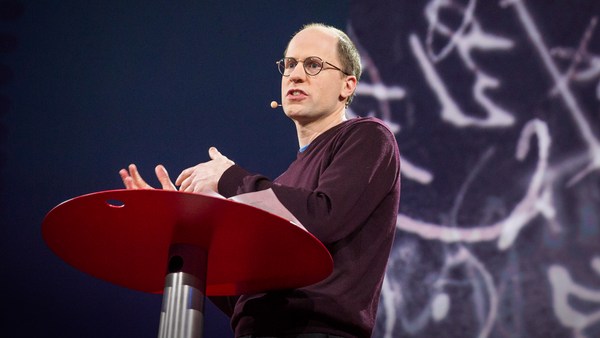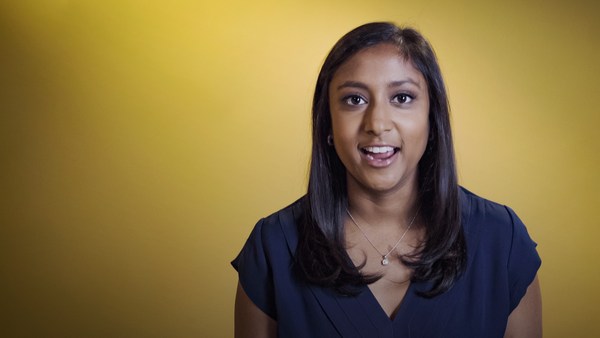Chris Anderson: Help us understand what machine learning is, because that seems to be the key driver of so much of the excitement and also of the concern around artificial intelligence. How does machine learning work?
Sebastian Thrun: So, artificial intelligence and machine learning is about 60 years old and has not had a great day in its past until recently. And the reason is that today, we have reached a scale of computing and datasets that was necessary to make machines smart. So here's how it works. If you program a computer today, say, your phone, then you hire software engineers that write a very, very long kitchen recipe, like, "If the water is too hot, turn down the temperature. If it's too cold, turn up the temperature." The recipes are not just 10 lines long. They are millions of lines long. A modern cell phone has 12 million lines of code. A browser has five million lines of code. And each bug in this recipe can cause your computer to crash. That's why a software engineer makes so much money. The new thing now is that computers can find their own rules. So instead of an expert deciphering, step by step, a rule for every contingency, what you do now is you give the computer examples and have it infer its own rules.
A really good example is AlphaGo, which recently was won by Google. Normally, in game playing, you would really write down all the rules, but in AlphaGo's case, the system looked over a million games and was able to infer its own rules and then beat the world's residing Go champion. That is exciting, because it relieves the software engineer of the need of being super smart, and pushes the burden towards the data. As I said, the inflection point where this has become really possible -- very embarrassing, my thesis was about machine learning. It was completely insignificant, don't read it, because it was 20 years ago and back then, the computers were as big as a cockroach brain. Now they are powerful enough to really emulate kind of specialized human thinking. And then the computers take advantage of the fact that they can look at much more data than people can. So I'd say AlphaGo looked at more than a million games. No human expert can ever study a million games. Google has looked at over a hundred billion web pages. No person can ever study a hundred billion web pages. So as a result, the computer can find rules that even people can't find.
CA: So instead of looking ahead to, "If he does that, I will do that," it's more saying, "Here is what looks like a winning pattern, here is what looks like a winning pattern."
ST: Yeah. I mean, think about how you raise children. You don't spend the first 18 years giving kids a rule for every contingency and set them free and they have this big program. They stumble, fall, get up, they get slapped or spanked, and they have a positive experience, a good grade in school, and they figure it out on their own. That's happening with computers now, which makes computer programming so much easier all of a sudden. Now we don't have to think anymore. We just give them lots of data.
CA: And so, this has been key to the spectacular improvement in power of self-driving cars. I think you gave me an example. Can you explain what's happening here?
ST: This is a drive of a self-driving car that we happened to have at Udacity and recently made into a spin-off called Voyage. We have used this thing called deep learning to train a car to drive itself, and this is driving from Mountain View, California, to San Francisco on El Camino Real on a rainy day, with bicyclists and pedestrians and 133 traffic lights. And the novel thing here is, many, many moons ago, I started the Google self-driving car team. And back in the day, I hired the world's best software engineers to find the world's best rules. This is just trained. We drive this road 20 times, we put all this data into the computer brain, and after a few hours of processing, it comes up with behavior that often surpasses human agility. So it's become really easy to program it. This is 100 percent autonomous, about 33 miles, an hour and a half.
CA: So, explain it -- on the big part of this program on the left, you're seeing basically what the computer sees as trucks and cars and those dots overtaking it and so forth.
ST: On the right side, you see the camera image, which is the main input here, and it's used to find lanes, other cars, traffic lights. The vehicle has a radar to do distance estimation. This is very commonly used in these kind of systems. On the left side you see a laser diagram, where you see obstacles like trees and so on depicted by the laser. But almost all the interesting work is centering on the camera image now. We're really shifting over from precision sensors like radars and lasers into very cheap, commoditized sensors. A camera costs less than eight dollars.
CA: And that green dot on the left thing, what is that? Is that anything meaningful?
ST: This is a look-ahead point for your adaptive cruise control, so it helps us understand how to regulate velocity based on how far the cars in front of you are.
CA: And so, you've also got an example, I think, of how the actual learning part takes place. Maybe we can see that. Talk about this.
ST: This is an example where we posed a challenge to Udacity students to take what we call a self-driving car Nanodegree. We gave them this dataset and said "Hey, can you guys figure out how to steer this car?" And if you look at the images, it's, even for humans, quite impossible to get the steering right. And we ran a competition and said, "It's a deep learning competition, AI competition," and we gave the students 48 hours. So if you are a software house like Google or Facebook, something like this costs you at least six months of work. So we figured 48 hours is great. And within 48 hours, we got about 100 submissions from students, and the top four got it perfectly right. It drives better than I could drive on this imagery, using deep learning. And again, it's the same methodology. It's this magical thing. When you give enough data to a computer now, and give enough time to comprehend the data, it finds its own rules.
CA: And so that has led to the development of powerful applications in all sorts of areas. You were talking to me the other day about cancer. Can I show this video?
ST: Yeah, absolutely, please. CA: This is cool.
ST: This is kind of an insight into what's happening in a completely different domain. This is augmenting, or competing -- it's in the eye of the beholder -- with people who are being paid 400,000 dollars a year, dermatologists, highly trained specialists. It takes more than a decade of training to be a good dermatologist. What you see here is the machine learning version of it. It's called a neural network. "Neural networks" is the technical term for these machine learning algorithms. They've been around since the 1980s. This one was invented in 1988 by a Facebook Fellow called Yann LeCun, and it propagates data stages through what you could think of as the human brain. It's not quite the same thing, but it emulates the same thing. It goes stage after stage. In the very first stage, it takes the visual input and extracts edges and rods and dots. And the next one becomes more complicated edges and shapes like little half-moons. And eventually, it's able to build really complicated concepts. Andrew Ng has been able to show that it's able to find cat faces and dog faces in vast amounts of images.
What my student team at Stanford has shown is that if you train it on 129,000 images of skin conditions, including melanoma and carcinomas, you can do as good a job as the best human dermatologists. And to convince ourselves that this is the case, we captured an independent dataset that we presented to our network and to 25 board-certified Stanford-level dermatologists, and compared those. And in most cases, they were either on par or above the performance classification accuracy of human dermatologists.
CA: You were telling me an anecdote. I think about this image right here. What happened here?
ST: This was last Thursday. That's a moving piece. What we've shown before and we published in "Nature" earlier this year was this idea that we show dermatologists images and our computer program images, and count how often they're right. But all these images are past images. They've all been biopsied to make sure we had the correct classification. This one wasn't. This one was actually done at Stanford by one of our collaborators. The story goes that our collaborator, who is a world-famous dermatologist, one of the three best, apparently, looked at this mole and said, "This is not skin cancer." And then he had a second moment, where he said, "Well, let me just check with the app." So he took out his iPhone and ran our piece of software, our "pocket dermatologist," so to speak, and the iPhone said: cancer. It said melanoma. And then he was confused. And he decided, "OK, maybe I trust the iPhone a little bit more than myself," and he sent it out to the lab to get it biopsied. And it came up as an aggressive melanoma. So I think this might be the first time that we actually found, in the practice of using deep learning, an actual person whose melanoma would have gone unclassified, had it not been for deep learning.
CA: I mean, that's incredible.
(Applause)
It feels like there'd be an instant demand for an app like this right now, that you might freak out a lot of people. Are you thinking of doing this, making an app that allows self-checking?
ST: So my in-box is flooded about cancer apps, with heartbreaking stories of people. I mean, some people have had 10, 15, 20 melanomas removed, and are scared that one might be overlooked, like this one, and also, about, I don't know, flying cars and speaker inquiries these days, I guess. My take is, we need more testing. I want to be very careful. It's very easy to give a flashy result and impress a TED audience. It's much harder to put something out that's ethical. And if people were to use the app and choose not to consult the assistance of a doctor because we get it wrong, I would feel really bad about it. So we're currently doing clinical tests, and if these clinical tests commence and our data holds up, we might be able at some point to take this kind of technology and take it out of the Stanford clinic and bring it to the entire world, places where Stanford doctors never, ever set foot.
CA: And do I hear this right, that it seemed like what you were saying, because you are working with this army of Udacity students, that in a way, you're applying a different form of machine learning than might take place in a company, which is you're combining machine learning with a form of crowd wisdom. Are you saying that sometimes you think that could actually outperform what a company can do, even a vast company?
ST: I believe there's now instances that blow my mind, and I'm still trying to understand. What Chris is referring to is these competitions that we run. We turn them around in 48 hours, and we've been able to build a self-driving car that can drive from Mountain View to San Francisco on surface streets. It's not quite on par with Google after seven years of Google work, but it's getting there. And it took us only two engineers and three months to do this. And the reason is, we have an army of students who participate in competitions. We're not the only ones who use crowdsourcing. Uber and Didi use crowdsource for driving. Airbnb uses crowdsourcing for hotels. There's now many examples where people do bug-finding crowdsourcing or protein folding, of all things, in crowdsourcing. But we've been able to build this car in three months, so I am actually rethinking how we organize corporations.
We have a staff of 9,000 people who are never hired, that I never fire. They show up to work and I don't even know. Then they submit to me maybe 9,000 answers. I'm not obliged to use any of those. I end up -- I pay only the winners, so I'm actually very cheapskate here, which is maybe not the best thing to do. But they consider it part of their education, too, which is nice. But these students have been able to produce amazing deep learning results. So yeah, the synthesis of great people and great machine learning is amazing.
CA: I mean, Gary Kasparov said on the first day [of TED2017] that the winners of chess, surprisingly, turned out to be two amateur chess players with three mediocre-ish, mediocre-to-good, computer programs, that could outperform one grand master with one great chess player, like it was all part of the process. And it almost seems like you're talking about a much richer version of that same idea.
ST: Yeah, I mean, as you followed the fantastic panels yesterday morning, two sessions about AI, robotic overlords and the human response, many, many great things were said. But one of the concerns is that we sometimes confuse what's actually been done with AI with this kind of overlord threat, where your AI develops consciousness, right? The last thing I want is for my AI to have consciousness. I don't want to come into my kitchen and have the refrigerator fall in love with the dishwasher and tell me, because I wasn't nice enough, my food is now warm. I wouldn't buy these products, and I don't want them. But the truth is, for me, AI has always been an augmentation of people. It's been an augmentation of us, to make us stronger. And I think Kasparov was exactly correct. It's been the combination of human smarts and machine smarts that make us stronger. The theme of machines making us stronger is as old as machines are. The agricultural revolution took place because it made steam engines and farming equipment that couldn't farm by itself, that never replaced us; it made us stronger. And I believe this new wave of AI will make us much, much stronger as a human race.
CA: We'll come on to that a bit more, but just to continue with the scary part of this for some people, like, what feels like it gets scary for people is when you have a computer that can, one, rewrite its own code, so, it can create multiple copies of itself, try a bunch of different code versions, possibly even at random, and then check them out and see if a goal is achieved and improved. So, say the goal is to do better on an intelligence test. You know, a computer that's moderately good at that, you could try a million versions of that. You might find one that was better, and then, you know, repeat. And so the concern is that you get some sort of runaway effect where everything is fine on Thursday evening, and you come back into the lab on Friday morning, and because of the speed of computers and so forth, things have gone crazy, and suddenly --
ST: I would say this is a possibility, but it's a very remote possibility. So let me just translate what I heard you say. In the AlphaGo case, we had exactly this thing: the computer would play the game against itself and then learn new rules. And what machine learning is is a rewriting of the rules. It's the rewriting of code. But I think there was absolutely no concern that AlphaGo would take over the world. It can't even play chess.
CA: No, no, no, but now, these are all very single-domain things. But it's possible to imagine. I mean, we just saw a computer that seemed nearly capable of passing a university entrance test, that can kind of -- it can't read and understand in the sense that we can, but it can certainly absorb all the text and maybe see increased patterns of meaning. Isn't there a chance that, as this broadens out, there could be a different kind of runaway effect?
ST: That's where I draw the line, honestly. And the chance exists -- I don't want to downplay it -- but I think it's remote, and it's not the thing that's on my mind these days, because I think the big revolution is something else. Everything successful in AI to the present date has been extremely specialized, and it's been thriving on a single idea, which is massive amounts of data. The reason AlphaGo works so well is because of massive numbers of Go plays, and AlphaGo can't drive a car or fly a plane. The Google self-driving car or the Udacity self-driving car thrives on massive amounts of data, and it can't do anything else. It can't even control a motorcycle. It's a very specific, domain-specific function, and the same is true for our cancer app. There has been almost no progress on this thing called "general AI," where you go to an AI and say, "Hey, invent for me special relativity or string theory." It's totally in the infancy.
The reason I want to emphasize this, I see the concerns, and I want to acknowledge them. But if I were to think about one thing, I would ask myself the question, "What if we can take anything repetitive and make ourselves 100 times as efficient?" It so turns out, 300 years ago, we all worked in agriculture and did farming and did repetitive things. Today, 75 percent of us work in offices and do repetitive things. We've become spreadsheet monkeys. And not just low-end labor. We've become dermatologists doing repetitive things, lawyers doing repetitive things. I think we are at the brink of being able to take an AI, look over our shoulders, and they make us maybe 10 or 50 times as effective in these repetitive things. That's what is on my mind.
CA: That sounds super exciting. The process of getting there seems a little terrifying to some people, because once a computer can do this repetitive thing much better than the dermatologist or than the driver, especially, is the thing that's talked about so much now, suddenly millions of jobs go, and, you know, the country's in revolution before we ever get to the more glorious aspects of what's possible.
ST: Yeah, and that's an issue, and it's a big issue, and it was pointed out yesterday morning by several guest speakers. Now, prior to me showing up onstage, I confessed I'm a positive, optimistic person, so let me give you an optimistic pitch, which is, think of yourself back 300 years ago. Europe just survived 140 years of continuous war, none of you could read or write, there were no jobs that you hold today, like investment banker or software engineer or TV anchor. We would all be in the fields and farming. Now here comes little Sebastian with a little steam engine in his pocket, saying, "Hey guys, look at this. It's going to make you 100 times as strong, so you can do something else." And then back in the day, there was no real stage, but Chris and I hang out with the cows in the stable, and he says, "I'm really concerned about it, because I milk my cow every day, and what if the machine does this for me?"
The reason why I mention this is, we're always good in acknowledging past progress and the benefit of it, like our iPhones or our planes or electricity or medical supply. We all love to live to 80, which was impossible 300 years ago. But we kind of don't apply the same rules to the future. So if I look at my own job as a CEO, I would say 90 percent of my work is repetitive, I don't enjoy it, I spend about four hours per day on stupid, repetitive email. And I'm burning to have something that helps me get rid of this. Why? Because I believe all of us are insanely creative; I think the TED community more than anybody else. But even blue-collar workers; I think you can go to your hotel maid and have a drink with him or her, and an hour later, you find a creative idea. What this will empower is to turn this creativity into action. Like, what if you could build Google in a day? What if you could sit over beer and invent the next Snapchat, whatever it is, and tomorrow morning it's up and running?
And that is not science fiction. What's going to happen is, we are already in history. We've unleashed this amazing creativity by de-slaving us from farming and later, of course, from factory work and have invented so many things. It's going to be even better, in my opinion. And there's going to be great side effects. One of the side effects will be that things like food and medical supply and education and shelter and transportation will all become much more affordable to all of us, not just the rich people.
CA: Hmm. So when Martin Ford argued, you know, that this time it's different because the intelligence that we've used in the past to find new ways to be will be matched at the same pace by computers taking over those things, what I hear you saying is that, not completely, because of human creativity. Do you think that that's fundamentally different from the kind of creativity that computers can do?
ST: So, that's my firm belief as an AI person -- that I haven't seen any real progress on creativity and out-of-the-box thinking. What I see right now -- and this is really important for people to realize, because the word "artificial intelligence" is so threatening, and then we have Steve Spielberg tossing a movie in, where all of a sudden the computer is our overlord, but it's really a technology. It's a technology that helps us do repetitive things. And the progress has been entirely on the repetitive end. It's been in legal document discovery. It's been contract drafting. It's been screening X-rays of your chest. And these things are so specialized, I don't see the big threat of humanity. In fact, we as people -- I mean, let's face it: we've become superhuman. We've made us superhuman. We can swim across the Atlantic in 11 hours. We can take a device out of our pocket and shout all the way to Australia, and in real time, have that person shouting back to us. That's physically not possible. We're breaking the rules of physics. When this is said and done, we're going to remember everything we've ever said and seen, you'll remember every person, which is good for me in my early stages of Alzheimer's. Sorry, what was I saying? I forgot.
CA: (Laughs)
ST: We will probably have an IQ of 1,000 or more. There will be no more spelling classes for our kids, because there's no spelling issue anymore. There's no math issue anymore. And I think what really will happen is that we can be super creative. And we are. We are creative. That's our secret weapon.
CA: So the jobs that are getting lost, in a way, even though it's going to be painful, humans are capable of more than those jobs. This is the dream. The dream is that humans can rise to just a new level of empowerment and discovery. That's the dream.
ST: And think about this: if you look at the history of humanity, that might be whatever -- 60-100,000 years old, give or take -- almost everything that you cherish in terms of invention, of technology, of things we've built, has been invented in the last 150 years. If you toss in the book and the wheel, it's a little bit older. Or the axe. But your phone, your sneakers, these chairs, modern manufacturing, penicillin -- the things we cherish. Now, that to me means the next 150 years will find more things. In fact, the pace of invention has gone up, not gone down, in my opinion. I believe only one percent of interesting things have been invented yet. Right? We haven't cured cancer. We don't have flying cars -- yet. Hopefully, I'll change this. That used to be an example people laughed about. (Laughs) It's funny, isn't it? Working secretly on flying cars. We don't live twice as long yet. OK? We don't have this magic implant in our brain that gives us the information we want. And you might be appalled by it, but I promise you, once you have it, you'll love it. I hope you will. It's a bit scary, I know.
There are so many things we haven't invented yet that I think we'll invent. We have no gravity shields. We can't beam ourselves from one location to another. That sounds ridiculous, but about 200 years ago, experts were of the opinion that flight wouldn't exist, even 120 years ago, and if you moved faster than you could run, you would instantly die. So who says we are correct today that you can't beam a person from here to Mars?
CA: Sebastian, thank you so much for your incredibly inspiring vision and your brilliance. Thank you, Sebastian Thrun. That was fantastic. (Applause)
